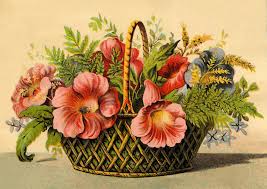 I have always wanted to visit Virginia for Garden Week, a seven or eight day extravaganza during which notable homes and gardens all over the state are open to the public. This year I finally had the chance to get to Virginia and it was a feast for the senses. One of the best parts of the trip, though, happened on the way, when I stopped off in Annapolis, Maryland on May 1.
I have always wanted to visit Virginia for Garden Week, a seven or eight day extravaganza during which notable homes and gardens all over the state are open to the public. This year I finally had the chance to get to Virginia and it was a feast for the senses. One of the best parts of the trip, though, happened on the way, when I stopped off in Annapolis, Maryland on May 1.
When people think about “May Day”, they might think of International Workers Day, still celebrated in some places. But “May Day’ has an older, more floriferous association as well. Annapolis, the capital of Maryland and home to the U.S. Naval Academy, has kept an especially lovely May Day tradition alive.
Ever since 1956, the Garden Club of Annapolis has held a May basket contest for residents and businesses. The rules are simple: contestants fill a basket or other container with spring flowers—either home grown or store-bought—and adorn those containers with ribbons and other decorative touches. The May baskets are positioned on front porches, stoops or in front of businesses by 10 am on May 1, at which time delegations of Garden Club judges make their rounds and judge the entries. Some homeowners and most businesses select themes for their May baskets. A bookstore, for example, might incorporate books, reading glasses or bookmarks into its May basket. Proud Annapolitan homeowners sometimes opt to add local touches like anchors or small crab replicas to their arrays of flowers and ribbons.
Every year people come from all over Maryland and beyond to view the May baskets, and the narrow streets are full of enraptured flower lovers taking pictures. Prizes are given out in different categories and the official celebration ends with an old-fashioned tea and afternoon party hosted by the Garden Club.
The Annapolis celebration is a descendant of the May basket tradition that was a staple in many American communities in the late nineteenth through the mid twentieth century. Every May 1, people would fill paper cones or baskets with garden flowers and sometimes small gifts and hang them on the doorknobs of lucky recipients. One widespread practice called for hanging the basket, ringing the doorbell and running away. If the recipient caught the basket donor, the donor had to give the recipient a kiss as well.
Author Louisa May Alcott of Little Women fame, described the May basket ritual in an 1880 children’s book titled Jack and Jill. Moving into the twentieth century, separate archival photos from the White House show First Ladies Grace Coolidge and Eleanor Roosevelt receiving May baskets from well-dressed children. I am not sure kissing was involved.
In some places flowery May Day festivals also involved dancing around a flower and ribbon-bedecked Maypole and crowning a May Queen.
All of this innocent-sounding fun harkens back to older spring celebrations in various parts of the Western Hemisphere, including the ancient Roman Floralia, which took place in mid-spring every three years and involved releasing sheep and goats, flinging flowers and making sacrifices to the goddess Flora. Germanic people celebrated Walpurgisnacht (St. Walpurg’s festival) in May and the Celts reveled during Beltane on the last day of April. Those celebrations were less about flowers and more about the fertility, renewal and the agricultural cycle, but the tradition of celebrating spring at the end of April or beginning of May was established.
It is never a bad thing to pause and take notice of the annual arrival of spring flowers and the renaissance of color and life. At a time when ugliness of all sorts seems omnipresent in society, it might be nice to get back to May baskets. I don’t think people would be receptive any more to the hanging/bell-ringing/running-away idea, but the Annapolis ritual of setting out May baskets in front of homes and businesses seems like a good idea all around. The many individuals who live and die by social media sites like Instagram could go all out posting May basket pictures. Everyone else would have a good reason to walk around neighborhoods and local business districts.
Next May 1, I will set out my own May basket, even if it the only one in my town or state. There is no downside to an array of beautiful spring flowers.
